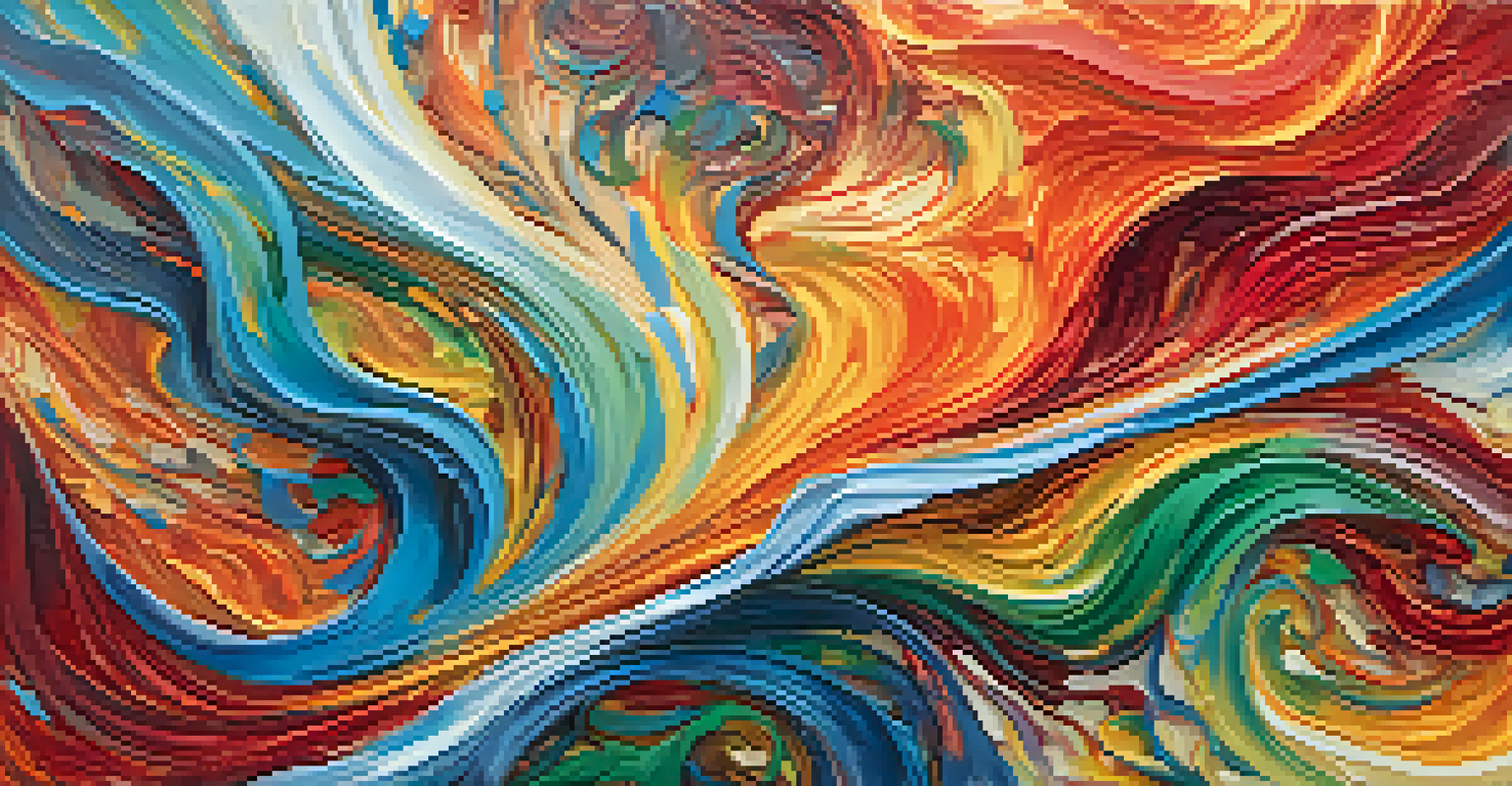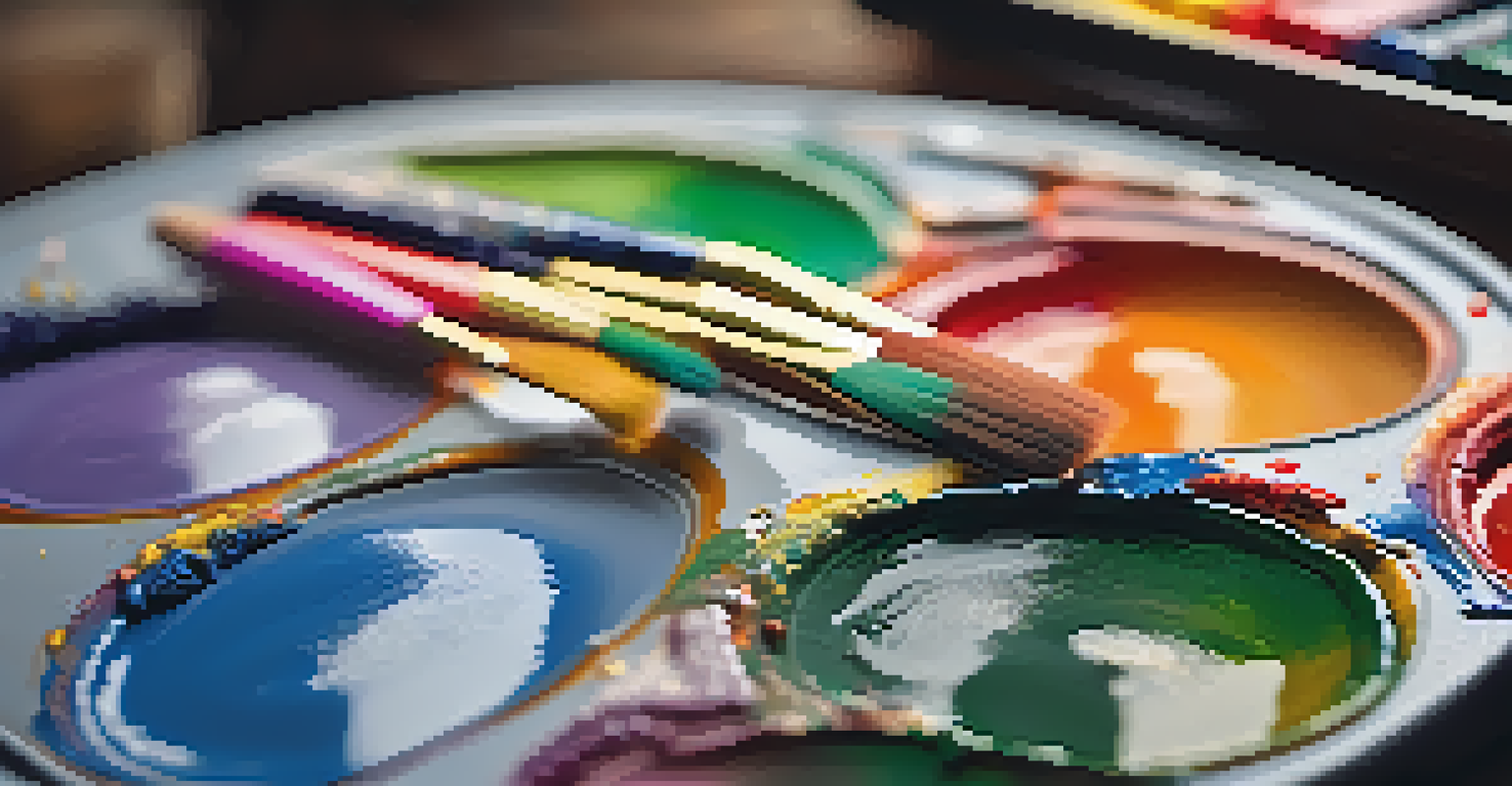Understanding Emotional Depth Through Varied Brush Techniques

The Connection Between Art and Emotion
Art has an incredible ability to evoke feelings, whether joy, sadness, or nostalgia. This connection is often achieved through the techniques an artist employs. Understanding how different brush techniques can convey various emotions is vital for both artists and art enthusiasts alike.
Every artist dips his brush in his own soul, and paints his own nature into his pictures.
When an artist chooses a specific brushstroke, it’s more than just a technical decision; it’s about the message they want to communicate. For instance, soft, feather-like strokes can impart a sense of tranquility, while sharp, jagged lines may evoke tension or chaos. This relationship between technique and emotion invites viewers to engage deeply with the artwork.
Ultimately, the emotional depth found in art is a reflection of the artist's intention and the viewer's interpretation. By exploring varied brush techniques, we can better understand how emotions are expressed and experienced within artistic creations.
Understanding Brush Techniques: The Basics
Before diving into emotional depth, it's essential to grasp the basic brush techniques. Common styles include dry brushing, wet-on-wet, and stippling, each producing distinct visual effects. For example, dry brushing creates a textured appearance, while wet-on-wet allows colors to blend seamlessly on the canvas.

These foundational techniques serve as tools for artists to express their feelings. As they gain confidence with these methods, artists can manipulate them to evoke specific emotional responses. Knowing how to control brush pressure, angle, and speed can dramatically alter the artwork's mood.
Art Evokes Deep Emotions
Art's ability to communicate emotions depends on the artist's brush techniques and the viewer's interpretation.
Mastering these techniques opens doors to myriad creative possibilities. Artists can experiment with various combinations, pushing the boundaries of traditional methods to discover new ways to express their emotional experiences.
The Role of Color in Emotional Expression
Color plays a pivotal role in conveying emotions in art, often working hand-in-hand with brush techniques. Warm colors like reds and oranges can evoke passion and excitement, while cool colors such as blues and greens may induce calmness or sadness. The choice of color can amplify the emotions portrayed through brushstrokes.
Color is the keyboard, the eyes are the harmonies, the soul is the piano with many strings.
For instance, an artist might use a bold, sweeping stroke in a fiery red to express anger, contrasting it with delicate blue hues to illustrate serenity. This interplay between color and technique allows artists to create a more profound emotional narrative within their work. It's like a dance where each element complements the other.
Understanding how color influences perception helps artists make informed decisions when creating their pieces. Combining different brush techniques with strategic color choices can lead to powerful emotional storytelling that resonates with viewers.
Expressive Brush Techniques: A Closer Look
Some brush techniques are particularly effective in conveying emotion. For example, a heavy impasto technique, where paint is laid on thick, can create a sense of movement and urgency. This method allows the artist to leave a tactile imprint, inviting viewers to connect more intimately with the artwork.
Conversely, soft washes can provide a sense of calm and fluidity, making the audience feel at ease. These techniques are often employed in landscapes or abstract works where the goal is to transport the viewer into a serene space. Each technique serves as a vessel for emotional expression, shaping how the artwork is perceived.
Color Amplifies Emotional Impact
The interplay of color and brush techniques enhances the emotional narrative within artworks.
By experimenting with these expressive techniques, artists can effectively communicate complex feelings. The choice of brushstroke not only impacts the visual outcome but also the emotional resonance that lingers in the viewer's mind.
Capturing Movement and Emotion
Movement is another crucial element in art that can significantly impact emotional depth. Artists can utilize dynamic brush techniques to create a sense of action or flow within their paintings. For instance, swirling strokes may evoke a sense of chaos, while steady lines can suggest calm and stability.
When emotion is tied to movement, the viewer is drawn into the narrative of the artwork. Think of a painting depicting a stormy sea; the turbulent brushstrokes can communicate both the power of nature and a sense of turmoil. This ability to capture movement allows for a richer emotional experience.
Ultimately, understanding how to manipulate movement through brush techniques empowers artists to create more engaging and emotionally charged pieces. This fusion of technique and feeling makes art a powerful medium for storytelling.
The Impact of Texture on Emotional Experience
Texture is an often-overlooked aspect of emotional expression in art. Different brush techniques can create varied textures, from smooth finishes to rough, tactile surfaces. These textural elements can significantly influence how a viewer interacts with a piece emotionally.
For example, a rough, textured surface may evoke feelings of discomfort or rawness, while a smooth finish might impart tranquility and softness. This sensory experience encourages viewers to engage with the artwork on a deeper level, fostering a personal connection to the emotions expressed.
Texture Shapes Viewer Experience
Different textures created by brush techniques significantly influence how viewers emotionally connect with the art.
Artists can experiment with texture to further enhance their emotional storytelling. By combining textures with expressive brush techniques, they can create layers of meaning that resonate with their audience, making the art experience more profound.
Personal Reflection and Emotional Resonance
As artists explore emotional depth through varied brush techniques, personal reflection plays a vital role. When an artist draws from their own experiences, it can lead to more authentic emotional expression. This authenticity often resonates with viewers, creating a shared emotional experience.
For example, an artist who has experienced loss may use darker colors and heavy, expressive strokes to communicate that grief. This personal touch can evoke empathy in viewers, allowing them to connect with the artwork on a deeper emotional level. It’s a reminder that art is not just a visual experience; it’s deeply personal.

Encouraging artists to reflect on their emotions can lead to more impactful and relatable work. This emotional resonance not only enriches the artwork but also fosters a sense of community among viewers who share similar feelings.
Conclusion: The Power of Brush Techniques in Art
In conclusion, understanding emotional depth through varied brush techniques can transform both the creation and appreciation of art. By mastering different techniques, artists gain the tools necessary to convey complex emotions effectively. This skill enhances their ability to connect with their audience on a profound level.
Moreover, recognizing the interplay of color, texture, and movement further enriches the artistic experience. Viewers can appreciate not just the visual beauty of a piece but also the emotional narrative behind it. This dual engagement makes art a powerful medium for communication.
Ultimately, the journey of exploring emotional depth through brush techniques is an ongoing process for both artists and viewers. By continuing to learn and experiment, we can deepen our understanding of art and the emotions it conveys.